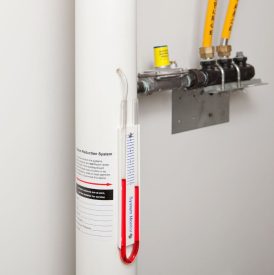January is National Radon Action Month and a great time to check the radon levels of your home. Even if you have previously tested for radon when you purchased your current home, it is important to monitor it regularly as levels can change over time.
Radon, a colorless and odorless gas, might be lurking in your home without you even knowing it. This naturally occurring radioactive gas is formed by the breakdown of uranium in soil, rock, and water. While it’s typically harmless when dispersed in outdoor air, elevated levels of radon indoors can pose serious health risks. In this article, we’ll delve into the importance of testing your home for radon, understanding its harmful effects, and the process of inspection and remediation.
RADON: WHAT YOU NEED TO KNOW
The Definition of Radon
Radon is a noble gas that doesn’t interact much with other elements. It enters homes through the ground, seeping through cracks and gaps in the foundation. Once indoors, radon can accumulate, especially in areas with poor ventilation. The primary concern is its radioactive decay products, which can be inhaled and damage lung tissue over time.
Harmful Effects
Exposure to elevated levels of radon is the leading cause of lung cancer among non-smokers and the second leading cause overall. The radioactive particles released during radon decay can damage lung cells, increasing the risk of cancer. Long-term exposure to radon is particularly concerning, as symptoms may not manifest until years later. It’s essential to note that smoking combined with radon exposure significantly amplifies the risk of lung cancer.
Testing Your Home for Radon
Testing for radon is a straightforward process that can be conducted by homeowners or professionals. Radon test kits are readily available at places like Home Depot and Lowes, and can be placed in various locations within your home. Testing is usually for 48 hours under closed conditions. It is easiest to test in seasons where you would already have the windows closed. The kits are then sent to a laboratory for analysis, and results are provided, indicating whether radon levels are within acceptable limits.
Professional radon testing services may use more advanced methods, such as continuous monitoring, providing a more accurate assessment of radon levels over time. It’s recommended to test your home every two years or after significant renovations that may impact the structure. If you would like to use a professional to text, contact us and we provide recommendations.
Testing for radon can range from $75-$200 but is well worth the investment.
Remediation
If test results reveal elevated radon levels, prompt remediation is crucial. Radon mitigation systems are designed to reduce indoor radon concentrations and vary depending on the home’s structure. The most common method involves installing a vent pipe system and an exhaust fan to redirect radon outdoors before it can accumulate inside.
Professional radon mitigation services can assess your home’s specific needs and implement effective solutions. Regular follow-up testing is essential to ensure that the mitigation system is working as intended and that radon levels remain within acceptable limits.
What If I Already Have a Radon System?
Even if you already have a radon system, it can be important to check the home’s radon levels over time to ensure that the system is working properly. The pressure gauge, the manometer, should show uneven levels. The manometer does NOT read the radon levels, but shows only pipe air pressures. If the levels are the same, then there is a problem with the system.
The only way to know radon levels after installing a radon system is to perform a radon retest. If you are unsure if your system is working properly, contact the company that installed your system for assistance.

Conclusion
Radon is a silent and invisible threat that can affect the air quality in your home and pose serious health risks. Testing your home for radon periodically is a simple yet crucial step in safeguarding your well-being. Understanding the harmful effects of radon and taking proactive measures through inspection and remediation can make your home a safer environment for you and your loved ones. Don’t let this silent intruder compromise your health—test for radon and take action to mitigate its risks.


